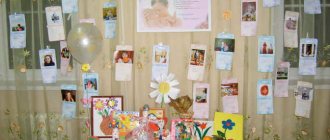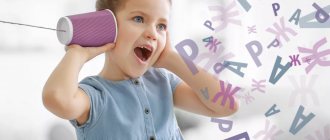The correct start of specialized exercises is the key to success
When planning classes, you need to initially decide on their purpose. This could be the general development and consolidation of existing skills or the correction of sounds that cause difficulties for the baby. In the first case, the necessary games are simply selected for a 4-5 year old child, often consisting of tongue twisters, rhymes and songs. In the second, the preparatory stage includes the following manipulations:
- We determine which sounds cause difficulties for the child. To do this, you need to show him pictures sequentially, he must name the things depicted on them. We select the pictures so that the experimental sound is in different parts of the words and combined with different letters.
- We plan lessons so that the easier sounds are worked on first, then the more complex ones.
- At the initial stages, work must be done with sounds, and not with words. It is necessary not only to repeat them many times, but also to pay due attention to the theoretical side of the issue. The baby must understand how to position the lips and tongue in order to form a specific sound.
- Speech therapy exercises for children are best presented in a playful way, then the information will be absorbed by a 4-5 year old child much more effectively.
- After the student makes progress with the first sound, we try to more actively introduce it into everyday speech. At the same time, we begin to master the next problematic point.
Don't count on too quick results. Subject to regular and high-quality work, the first successes may appear only after a few months. The main thing is not to deviate from the plan and continue studying.
Effective exercises for making the sound “r”
Most often, kids have problems pronouncing the sound “r”. They simply skip it or try to replace it with another, distorting the words. Before you begin correction, you should visit a pediatrician and speech therapist. Perhaps the cause of the problem lies in the short frenulum of the tongue and it will have to be solved surgically. Children 4-5 years old may have difficulty pronouncing the sound itself or using it in words. Depending on the situation, we structure classes. Some exercises may require a special spatula.
- The baby opens his mouth, presses his tongue to the base of his upper teeth, and clearly pronounces the letter “d” several times. He should feel the vibration characteristic of the sound “r”.
- The child opens his mouth and begins to pronounce the sound “zh”, gradually raising his tongue. An adult should carefully move the tongue with a spatula from side to side, increasing the vibration.
- The child pronounces the syllable “za,” while trying to pull his tongue back as much as possible. If an adult moves the baby’s tongue with a spatula at this time, the sound “r” will clearly appear.
Thanks to daily repetitions, the baby will have an understanding of how the sound “r” should sound, he will hear himself pronounce it, and this will speed up the process of speech development.
High-quality warm-up for lips and tongue
Each approach must begin with a special warm-up that can prepare the basic tools of speech. The baby should sit straight in front of the mirror, straighten his back and relax his body. It is necessary to achieve such a position that the child can see both his own face and the face of the “teacher”. Next, we begin to show and describe to the child the exercises that he must repeat. If necessary, we correct the baby’s actions with a spoon or a clean finger.
For a 4-5 year old child, the following exercises are ideal as a warm-up:
- We stretch our lips into a smile without showing our teeth.
- We stretch out the lips in the form of a proboscis.
- Keeping our jaws clenched tightly, we try to raise our upper lip.
- We stretch our lips into a tube and begin to make rotational movements with them.
- We stretch our lips, grab them with our fingers and gently massage.
- We work with the cheeks: we inflate both, inflate one at a time, deflate, then retract in the same order.
- Open your mouth, stick out your tongue and lick your lips in a circle.
- We stick out our tongue and stretch it up and down.
- Open your mouth and pull the lower jaw down, while pressing your tongue on the roof of your mouth.
It is worth considering that at the age of 4-5 years, children are not yet able to concentrate their attention on the same type of actions for too long. You shouldn’t force your child to do long-term activities; everything should be fun.
Speech characteristics of children 4-5 years old
For preschoolers, this time is a period of active vocabulary growth (by the age of 5, its volume normally reaches 3 thousand words). Children of this age begin to acquire a sense of language, handle their native speech more confidently, and engage in word creation. The grammatical structure continues to level out too.
A child of four or five years old not only begins to speak more and more freely, he also uses more and more complex sentences than before. The ability to compose a short story not only about what the child saw personally, but also without relying on his own direct experience, gradually develops. Such stories are still emotional and often have a broken logical structure, but they are quite voluminous and meaningful.
The level of phonetic perception of speech by this age also becomes significantly better. The child has the opportunity to determine the presence of a particular sound in a word and select words for a specific sound. He becomes able to perceive the syllabic rhythm of the structure of a word.
We can say that at the age of four, children begin the most active period in speech development, which allows them to acquire communicative capabilities comparable to the level of adults. Of course, it is rare that a child goes through this path without difficulties; speech disorders at this stage are most common.
Types of speech disorders in older preschoolers
There are three main types of disorders and speech underdevelopment:
- phonetic;
- phonetic-phonemic;
- general.
In practice, this means that children have difficulty recognizing, distinguishing and pronouncing the sounds of their native language. These three types of disorders can occur separately or in combination.
Normally, by this stage of development, natural age-related difficulties with the pronunciation of individual sounds or their groups should already be a thing of the past. The stage of mastering sound pronunciation is completed, children stop skipping and softening consonants in speech. At 4 years old, all hissing sounds should appear, and by 5 years old, you can expect a confident L and R sound. But in older preschoolers, articulation disorders are very common. These may be defects in the pronunciation of hissing, whistling, sonorant sounds. Almost all children have to perform speech therapy exercises on the letter and sound r; many manage to “growl” only after special training.
It is also worth paying attention to lexical and grammatical problems, which manifest themselves in the difficulties of actively using speech as a means of communication. Children with such disorders experience difficulty in composing questions and descriptions, and cannot use all the means of their native language to express thoughts. They do not know how to construct sentences correctly, use endings and prepositions incorrectly, and make mistakes when forming words. Speech therapy help in this case is necessary, but parents can also help the child speak better (of course, after consultation with a specialist).
Tests to determine pathologies
To quickly respond to changes in the baby’s development, you can conduct simple tests.
- By the fourth year, children can already distinguish the simplest geometric shapes. You need to ask the child to draw a circle. Even the similarity of this figure is a good result. However, if the child does not understand what is wanted from him, or his drawing does not even remotely resemble what is required, the test has not been passed.
- If a child does not show interest in new games and does not assemble a small tower from cubes, development is slow.
- By the age of three, the toddler communicates in short phrases (those who at this age already speak in long sentences are not taken into account). The minimum milestone for speech development by 3-4 years is the simplest phrases. If the child does not pronounce them, you should go to a specialist.
In what cases is it still necessary to contact a speech therapist:
- The baby does not respond to his name and does not understand simple requests.
- Shows no interest in new toys; all his game scenarios follow the pattern.
- He cannot assemble a simple turret or put a large bead on a rope.
- If by the age of three the child does not speak, there were injuries during pregnancy or early development, or there are hereditary diseases.
Characteristics of the development of a 3-4 year old child
At 3 years old, the child is open to learning his native language, he happily repeats everything after an adult and is actively engaged in word formation. By the age of 4, the passive vocabulary reaches 2,500 words, most of which are verbs and nouns.
The child’s speech also contains:
- simple adjectives (beautiful, small, big);
- possessive pronouns (my);
- generalization words (animals, vegetables).
A preschooler does not yet have much life experience and produces new words in his own way. This gives rise to curious word forms, for example: “Mom is studying, but I am a lazybones.” A three-year-old child is able to maintain a simple dialogue.
The most difficult sounds to pronounce are “R” and “L”, as well as the whistling “Sh”, “S”, “F”. Often, even after reaching four years of age, the child is not able to pronounce them.
Important! If at 3-4 years old a child does not pronounce all sounds clearly, this is not a reason to run to a speech therapist. The sounds “R”, “L”, “Sh”, “S”, “F” are usually introduced at a later age. However, if by the age of 3 the baby does not speak at all, and there were serious illnesses or injuries during pregnancy/birth/in the first year, consultation with specialists is required. Based on the results of the examinations, a psychologist, speech therapist and neurologist will tell you what speech therapy exercises for children 3-4 years old should be performed.
![Letter L and sound [l]](https://pleshakof.ru/wp-content/uploads/bukva-l-i-zvuk-l-330x140.jpg)









